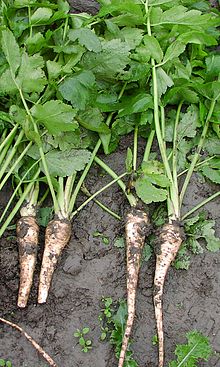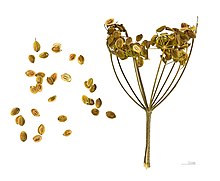Parsnip
From Wikipedia, the free encyclopedia
Not to be confused with Cow parsnip.

| Parsnip | |
|---|---|
| Scientific classification | |
| Kingdom: | Plantae |
| (unranked): | Angiosperms |
| (unranked): | Eudicots |
| (unranked): | Asterids |
| Order: | Apiales |
| Family: | Apiaceae |
| Genus: | Pastinaca |
| Species: | P. sativa |
| Binomial name | |
| Pastinaca sativa L.[1] | |
The parsnip (Pastinaca sativa) is a root vegetable closely related to the carrot. It is a biennial plant usually grown as an annual. Its long tuberous root has cream-colored skin and flesh and can be left in the ground when mature as it becomes sweeter in flavour after winter frosts. In its first growing season, the plant has a rosette of pinnate, mid-green leaves. If unharvested, it produces its flowering stem, topped by an umbel of small yellow flowers, in its second growing season. By this time the stem is woody and the tuber inedible. The seeds are pale brown, flat and winged.
Uses
Parsnips resemble carrots and can be used in similar ways but they have a sweeter taste, especially when cooked.[13] While parsnips can be eaten raw, they are more commonly served cooked. They can be baked, boiled, pureed, roast, fried or steamed. When used in stews, soups and casseroles they give a rich flavor.[7] In some cases, the parsnip is boiled and the solid portions are removed from the soup or stew, leaving behind a more subtle flavor than the whole root, and starch to thicken the dish. Roast parsnip is considered an essential part of Christmas dinner in some parts of the English-speaking world and frequently features in the traditional Sunday Roast. [14] Parsnips can also be fried or thinly sliced and made into crisps. Parsnips can be made into a wine that has a taste similar to Madeira.[15]
[edit]Nutritional properties
| Nutritional value per 100 g (3.5 oz) | |
|---|---|
| Energy | 314 kJ (75 kcal) |
| Carbohydrates | 18 g |
| - Sugars | 4.8 |
| - Dietary fiber | 4.9 g |
| Fat | 0.3 g |
| Protein | 1.2 g |
| Water | 79.53 g |
| Thiamine (vit. B1) | 0.09 mg (8%) |
| Riboflavin (vit. B2) | 0.05 mg (4%) |
| Niacin (vit. B3) | 0.7 mg (5%) |
| Pantothenic acid (B5) | 0.6 mg (12%) |
| Vitamin B6 | 0.09 mg (7%) |
| Folate (vit. B9) | 67 μg (17%) |
| Vitamin C | 17 mg (20%) |
| Vitamin E | 1.49 mg (10%) |
| Vitamin K | 22.5 μg (21%) |
| Calcium | 36 mg (4%) |
| Iron | 0.59 mg (5%) |
| Magnesium | 29 mg (8%) |
| Manganese | 0.56 mg (27%) |
| Phosphorus | 71 mg (10%) |
| Potassium | 375 mg (8%) |
| Sodium | 10 mg (1%) |
| Zinc | 0.59 mg (6%) |
| Link to USDA Database entry Percentages are relative to US recommendations for adults. Source: USDA Nutrient Database | |
A typical 100 gm parsnip contains 75 Calories (230 kJ) of energy. Most parsnip cultivars consist of about 80% water, 5% sugar, 1% protein, 0.3% fatand 5% dietary fiber. The parsnip is rich in vitamins and minerals and is particularly rich in potassium with 375 mg per 100 gm.[17] Several of the B-group vitamins are present but most of the vitamin C is lost in cooking. Since most of the vitamins and minerals are found close to the skin many will be lost unless the root is finely peeled or cooked whole. During frosty weather, part of the starch is converted to sugar and the root tastes sweeter.[18]
The consumption of parsnips has potential health benefits. They contain anti-oxidants such as falcarinol, falcarindiol, panaxydiol and methyl-falcarindiol which have anti-cancer, anti-inflammatory and anti-fungal properties. The dietary fiber in parsnips is partly of the soluble and partly the insoluble type and comprises cellulose, hemicellulose and lignin. The high fiber content of parsnips may help prevent constipation and reduce blood cholesterol levels.[19]
[edit]Etymology
While folk etymology sometimes assumes the name is a portmanteau of its close relatives parsley and turnip, it actually comes from Middle Englishpasnepe, alteration (influenced by nep, turnip) of Old French pasnaie (now panais) from Latin pastinum, a kind of fork, whose ending was changed to -nip by analogy with turnip because it was assumed to be a kind of turnip.[20]
[edit]Cultivation
Parsnips are biennials, normally grown as annuals and a favorite with gardeners in areas with short growing seasons. Sandy, loamy soil is preferred; silty, clayey, and stony soils are unsuitable, as they produce short, forked roots. Parsnip seed significantly deteriorates in viability if stored for long, so it is advisable to use fresh seed each year. Seeds can be planted in early spring, as soon as the ground can be worked to a fine tilth. Seed is sown 2 cm (0.8 in) deep in rows 30 cm (12 in) apart in the position where the plants are to grow. They are thinned to a distance of 7 to 10 cm (3 to 4 in) depending on whether they are small or large cultivars. Alternatively, they can be station sown with groups of three seeds sown at intervals. A fast-growing crop such as radishes can be intersown between the stations and the parsnips can be thinned down to a single seedling at each after the radishes have been harvested. The crop should be kept weed free during the growing season. Harvesting can begin in late fall after the first frost, and continue through winter. The foliage dies back so it is best to mark the row with canes. In severe weather, the rows can be covered with straw to enable the crop to be lifted during frosty weather.[21] Parsnips are hardy winter vegetables and low soil temperatures enhance their flavor, as some of the carbohydrates stored in the roots get converted into sugars.[22]
[edit]Cultivation problems
Parsnip leaves are sometimes tunnelled by the larvae of the celery leaf miner (Euleia heraclei). Irregular pale brown passages can be seen meandering between the upper and lower surfaces of the leaves. The effects are most serious on young plants as whole leaves may shrivel and die. Treatment is by removing affected leaflets or whole leaves, or by chemical means.[21]
The crop can be attacked by larvae of the carrot fly (Chamaepsila rosae). This pest feeds on the outer layers of the root, burrowing its way inside later in the season. Seedlings may be killed while larger roots are rendered useless. The damage done provides a point of entry for fungal rots and canker. The fly is attracted by the smell of bruised tissue and damage can be minimized by sowing thinly, providing good growing conditions, avoiding thinning the plants and weeding carefully.[23] Parsnip is used as a food plant by the larvae of some Lepidopteran species including the parsnip swallowtail, the common swift moth, the garden dart moth and the ghost moth.[24] The larvae of the parsnip moth (Depressaria radiella), native to Europe and accidentally introduced to North America in the mid-1800s, construct their webs on the umbels, feeding on flowers and developing seeds.[25]
Parsnip canker is a serious disease of this crop. Black or orange-brown patches occur around the crown and shoulders of the root accompanied by cracking and hardening of the flesh. It is more likely to occur when seed is sown into cold, wet soil, the pH of the soil is too low or the roots have already been damaged by carrot fly larvae. Better results may be obtained by choosing a resistant variety and sowing later in the season, producing smaller, more closely spaced plants.[26] Several fungi are associated with canker, including Phoma complanata, Ilyonectria radicicola,Itersonilia pastinaceae, and I. perplexans. In Europe, Centrospora acerina has been found to cause a black rot that kills the plant early.[27] Watery soft rot, caused by Sclerotinia minor andS. sclerotiorum, causes the taproot to become soft and watery. A white or buff-colored mold grows on the surface. The pathogen is most common in temperate and subtropical regions that have a cool wet season.[28]
Violet root rot caused by the fungus Helicobasidium purpureum sometimes affects the roots, covering them with a purplish mat to which soil particles adhere. The leaves become distorted and discoloured and the mycelium can spread through the soil between plants. Some weeds can harbour this fungus and it is more prevalent in wet, acid conditions. Affected plants should be removed and burnt and susceptible crops should not be grown in the area for four years.[21] Erysiphe heraclei causes a powdery mildew that can cause significant crop loss. Infestation by this causes results in yellowing of the leaf and loss of foliage. Moderate temperatures and high humidity favor the development of the disease.[29]
Several viruses are known to infect the plant, including seed-borne strawberry latent ringspot virus, parsnip yellow fleck virus, parsnip leafcurl virus, parsnip mosaic potyvirus, and potyvirus celery mosaic virus. The latter causes clearing or yellowing of those areas of the leaf immediately aligning the veins, the appearance of ochre mosaic spots, and leaf crinkling in infected plants.[30]
[edit]Dangers
While the root of the parsnip is edible, handling the shoots and leaves of the plant requires caution as the sap is toxic.[31] Like many other members of the family Apiaceae, the parsnip containsfuranocoumarin, a photosensitive chemical that causes a condition known as phytophotodermatitis.[31] The condition is a type of chemical burn rather than an allergic reaction, and is similar to the rash caused by poison ivy. Symptoms include redness, burning, and blisters. Afflicted areas can remained discolored for up to two years.[32] Although there have been some reports of gardeners experiencing toxic symptoms after coming into contact with foliage,[33] these have been small in number compared to the number of people that grow the crop. The problem is most likely to occur on a sunny day when gathering foliage or pulling up old plants that have gone to seed. The symptoms have mostly been mild to moderate.[34] The toxic properties of parsnip extracts are resistant to heating, or a storage period of several months. Toxic symptoms can also affect livestock and poultry in parts of their bodies where their skin is exposed.[35]
Polyacetylenes can be found in Apiaceae vegetables like parsnip, and they show cytotoxic activities.[36]

No comments:
Post a Comment